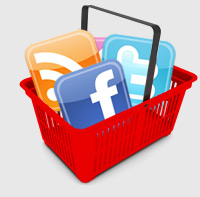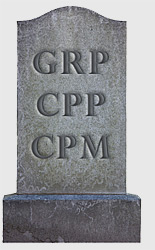I’d Buy a Lot of Things, Ideally. But I Won’t Buy Tweets.
 Recently, the Center for Media Research announced the release of its “2010 Media Planning Intelligence Study” — an online survey of more than 1,000 media buyers and planners. What is the big nugget cast to peak readers’ interest? As reported by BtoB’s Media Business, the results state that 56% of media buyers plan to buy ads on social networks next year. Beyond what buyers plan to do, the survey also asked them to categorize their preferred media buys as “ideally” and “realistically.” Not surprisingly, social networks were the top “ideal” buy for this audience.
Recently, the Center for Media Research announced the release of its “2010 Media Planning Intelligence Study” — an online survey of more than 1,000 media buyers and planners. What is the big nugget cast to peak readers’ interest? As reported by BtoB’s Media Business, the results state that 56% of media buyers plan to buy ads on social networks next year. Beyond what buyers plan to do, the survey also asked them to categorize their preferred media buys as “ideally” and “realistically.” Not surprisingly, social networks were the top “ideal” buy for this audience.
I’d buy a lot of things, ideally. I’d talk to the NFL about being the sole sponsor of the Super Bowl, ideally. Print publications would let me get consistent placement in specifice content — not just covers, mastheads or TOC’s, ideally. I’d buy the patent to DVRs and toss it to the scrap heap (not really, but you get the point).
The difference between “ideally” and “realistically” is not simply a matter of desire versus budget. At least it shouldn’t be. The difference here is likely more rooted in an “I need some of that” philosophy regarding social media, with a dab of “but how” in the realistic-implementation department.
 A huge problem in the world of media buying, planning and selling (don’t forget selling) is getting outside the comfort zone. It is easy and comfortable to continue with our GRPs, CPPs, CPMs, and happy reach and frequency scales. Neither the buying nor the selling side is often overflowing with creative solutions to the broken acronym system. Anyone who remembers the late 1990s in the world of advertising will recall the glory of the internet all rolled up into one tremendous “click.” Buyers and sellers were giddy with the word click the way Beavis was with fire. I mean truly, it was fascinating to sellers who no longer just sold impressions and reach; they could sell you an action. As it turns out, that action — minus some pretty serious engagement if not sales — is a pretty weak metric. And so here we are, an entire decade later. We’ve evolved tremendously, right? We are learning, right? Not so much.
A huge problem in the world of media buying, planning and selling (don’t forget selling) is getting outside the comfort zone. It is easy and comfortable to continue with our GRPs, CPPs, CPMs, and happy reach and frequency scales. Neither the buying nor the selling side is often overflowing with creative solutions to the broken acronym system. Anyone who remembers the late 1990s in the world of advertising will recall the glory of the internet all rolled up into one tremendous “click.” Buyers and sellers were giddy with the word click the way Beavis was with fire. I mean truly, it was fascinating to sellers who no longer just sold impressions and reach; they could sell you an action. As it turns out, that action — minus some pretty serious engagement if not sales — is a pretty weak metric. And so here we are, an entire decade later. We’ve evolved tremendously, right? We are learning, right? Not so much.
I bore witness this summer to one of the most poorly conceived RFP answers ever received in my media career. A television station trying to sell one of my planners “tweets” at $50 a pop for a client’s campaign this fall. Let me put that into perspective for you, in case you are only laughing at the idea of paying for a tweet but are not familiar with the decaying math of media buying and selling. The aforementioned television station built the pricing on a CPM basis, or cost per thousand. So in essence you have the privilege of paying them $50 to reach their 1,500 followers. Ah-ha, social media solution, sell it like it is a thirty second television commercial. Return to laughing.
This is not to say that there are not opportunities to buy advertising within the social media ecosystem, or that those buys are not potentially very good for brands. Altimer and Wetpaint released a study this July which discussed how engagement on social media platforms benefits brands. Number one on that list is Starbucks, who not only does a great job of engagement on social platforms, but buys engagement advertising to promote their presence.
The evidence is overwhelming — the days of just hammering our customers with as many impressions as possible and waiting for the anecdotal reaction are dead. The consumer expects more and, frankly, demands more. Content providers and many brands are implementing a wide array of tactics to find what fits. These include, but are not limited to, the traditional sponsored approach but also include a localized “impact the social water cooler” method. Somewhat ironically, the advertiser in both linked instances is McDonald’s. I can’t fault them for putting their eggs in each basket, though I suspect they will get more out of their attempt to generate conversation than they will by simply associating with US Weekly’s Facebook content. Still sponsoring content is much more realistic (if not ideal) and certainly less laughable than buying tweets.




